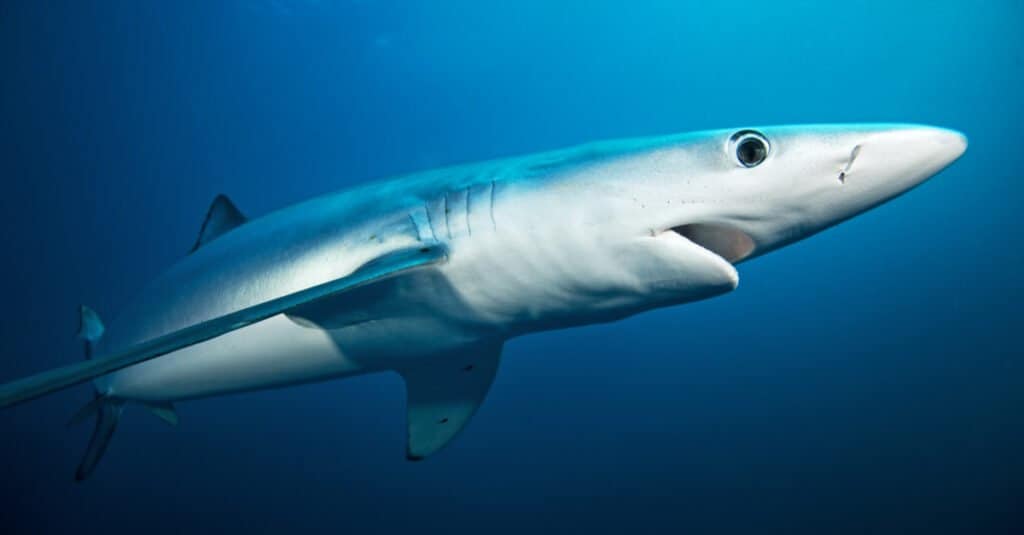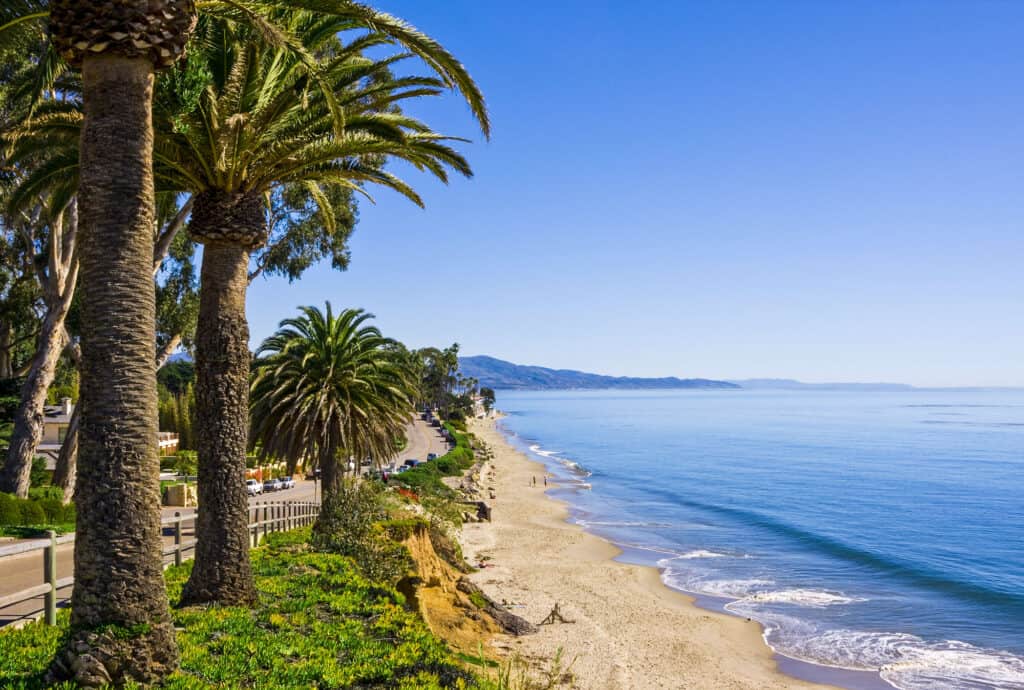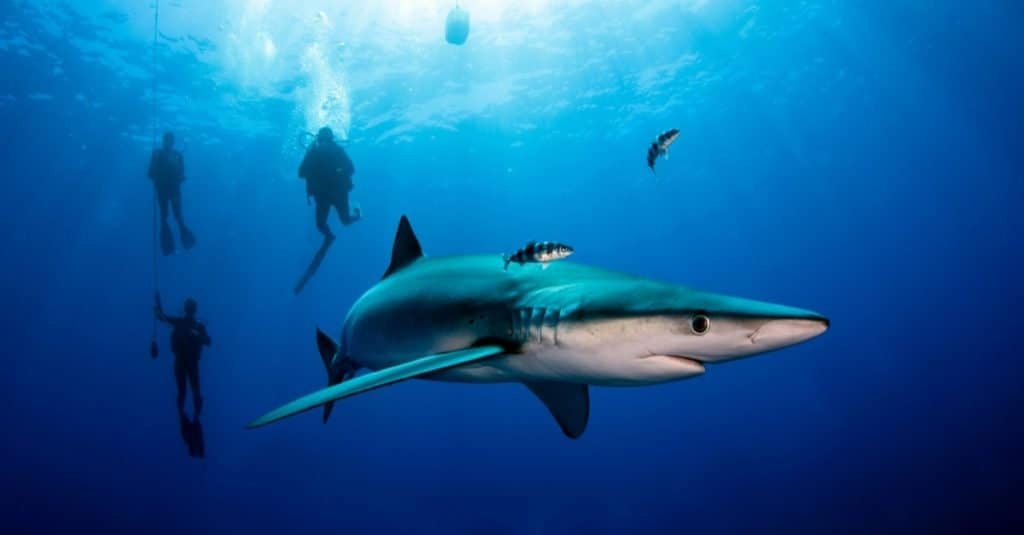Blue sharks (Prionace glauca) are a common and widespread shark species found in all the world’s oceans, including California‘s coast.
These sharks are important predators in the marine ecosystem as they help maintain the balance of the food chain. In California, blue sharks are regularly sighted and interacted with by divers and anglers due to their inquisitive and curious nature. But despite their prevalence in California waters, blue sharks face several threats that could potentially impact their population in the state.
In this article, we discover the largest blue shark ever caught in California. We also provide a comprehensive overview of blue sharks in California, covering their physical characteristics, diet, distribution, predators, threats, conservation efforts, and the role of ecotourism in their protection.
The Largest Blue Shark Ever Caught in California
The largest blue shark ever caught in California weighed an impressive 258 lbs. 8 oz. Angler Josh Ware Bolinger caught the massive fish at the Chanel Islands in Santa Barbara County on August 29, 2008.
Bolinger caught the fish by lure during his ocean-angling adventure, breaking the state record for the species held by Robert L. Ballew at the time. Ballew’s catch weighed 231 lbs. 1 oz. He caught the fish on August 1, 1974, at Santa Cruz Island in Santa Barbara County in one of his ocean diving adventures.
The Largest Blue Shark Ever Caught Worldwide
The International Game Fish Association (IGFA) record for the largest blue shark ever caught is a 528-pound (239.49 kg) specimen. It was caught by angler Roberto Godi on July 6, 2001, off the coast of Porto Recanati, Italy.
Physical Characteristics of Blue Sharks
Blue sharks have a sleek and slender body shape. It enables them to swim quickly and efficiently through the water. They have a distinctive blue coloration on their dorsal (upper) side and a white underside, making them easy to identify.
Appearance
A blue shark’s body is long and slender, with a pointed snout and large, round eyes positioned forward on the head. They have 5-6 gill slits located on the sides of their body, and their dorsal fin is high and pointed.
Blue sharks also have two pectoral fins, two pelvic fins, and an asymmetrical caudal (tail) fin that helps them to swim quickly.
Size and Weight
Adult blue sharks can reach lengths of up to 12 feet and weigh 200-400 lbs. Females are typically larger than males, and their size can vary depending on their age, sex, and geographic location.

Blue sharks have a sleek and slender body shape. It enables them to swim quickly and efficiently through the water.
©Martin Prochazkacz/Shutterstock.com
Breeding
Blue sharks reproduce through a process known as oviparity, in which eggs are fertilized inside the female’s body and then deposited in the water to hatch.
While this reproduction mode is common in many shark species, blue sharks are also capable of producing live young through a process known as viviparity.
Reproduction
During the breeding season, typically in the late spring and early summer, male blue sharks will seek out potential mates using their keen senses of smell and electromagnetic detection.
Once a male has located a receptive female, he will bite onto her pectoral fin and use his claspers to transfer sperm into her reproductive tract.
Gestation and Birth
The gestation period for blue sharks can vary depending on various factors, including:
- The age and size of the female
- Environmental conditions
Once the embryos have developed sufficiently, they will hatch from their egg cases or be born alive, depending on the mode of reproduction.
Female blue sharks typically give birth to litters of 25-100 pups, born fully developed and able to swim immediately after birth.
Maturation and Life Span
Blue sharks mature relatively slowly, with females not reaching sexual maturity until they’re 5-6 years old and males 4-5 years old.
Blue sharks’ life span isn’t well understood but is believed to be around 20 years in the wild.
Diet and Feeding Habits
Blue sharks are opportunistic predators that will feed on various prey.
Their diet consists mainly of small to medium-sized fish, such as mackerel, herring, and sardines, as well as squid and crustaceans.
Prey
Blue sharks feed on other shark species, such as dogfish and hound sharks, as well as smaller bony fish. They also scavenge on dead animal carcasses, including whales and other sharks.
Hunting Behavior
Blue sharks use their keen senses to locate prey, including their:
- Sense of smell
- Ability to detect electromagnetic fields produced by their prey
Once they have located a potential food source, they’ll circle it to determine the best attack angle before lunging forward to bite.
Blue sharks are capable of bursts of high-speed swimming when hunting, enabling them to catch fast-moving prey.
Role in the Ecosystem
As top predators, blue sharks play a vital role in the marine ecosystem by regulating the populations of their prey species.
They’re also preyed upon by larger sharks and killer whales, which helps to maintain the balance of the food chain.
Predators
Blue sharks, like all shark species, have natural predators that play a role in regulating their populations.
In addition to these natural predators, humans also pose a significant threat to blue sharks.
Natural Predators
Larger shark species, such as the great white and tiger sharks, prey on blue sharks.
Killer whales, also known as orcas, are another natural predator of blue sharks. These predators help to maintain the balance of the marine ecosystem by controlling the population of blue sharks and other prey species.
Human Predators
Humans are significant blue shark predators. The species is regularly caught as bycatch by commercial fishing operations targeting other species, such as tuna and swordfish. Blue sharks are also targeted for their meat, fins, and liver oil, which are used in various products.
Distribution and Migration
Blue sharks are a cosmopolitan species found in all the world’s oceans, including the waters off California’s coast.
They prefer temperate and tropical waters. Their range extends from the surface down to depths of around 1,000 feet.
Geographical Range
In California, blue sharks are most commonly found in the waters off the coast during summer.
They frequent areas with high concentrations of their preferred prey, such as
- Upwelling zones
- Offshore islands
Blue sharks also travel great distances, with some individuals recorded traveling up to 3,700 miles in a single migration.
Seasonal Movement
Blue sharks exhibit seasonal movements, with individuals typically moving closer to the coast during summer when their preferred prey is more abundant.
During winter, they tend to move offshore to deeper waters.
Migration Patterns
Blue sharks undertake long-distance migrations, traveling across entire ocean basins to reach their preferred feeding and breeding grounds.
Blue sharks’ migration patterns aren’t fully understood. But research has suggested that they may follow the temperature gradients of the water, as well as ocean currents and other environmental cues.

In California, blue sharks are most commonly found in the waters off the coast during summer.
©iStock.com/DavidMSchrader
Threats to Blue Sharks in California
Blue sharks in California face several threats that could impact their population in the state.
Overfishing
Blue sharks are often caught as bycatch in commercial fishing operations targeting other species, such as tuna and swordfish.
The high demand for their meat, fins, and liver oil has led to the overfishing of the species in some regions, including California.
Bycatch
In addition to being caught intentionally, fishermen also catch blue sharks as bycatch in other fishing operations, such as gillnet fisheries.
Bycatch can have a significant impact on blue sharks’ survival, particularly in areas where fishing pressure is high.
Climate Change
Climate change is also a threat to blue sharks in California. Several factors can impact the distribution and abundance of their prey, which could have ripple effects throughout the food chain. They include:
- Ocean acidification
- Changes in ocean currents
- Rising ocean temperatures
Climate change can also impact the availability of suitable breeding and nursery habitats for blue sharks, further impacting their survival.
Conservation Efforts
Efforts to protect blue sharks in California and around the world are ongoing. They include various measures aimed at reducing threats to the species and promoting their conservation, such as:
- Legal protection
- Fishing regulations
- Research and monitoring
Legal Protection
Blue sharks are protected under several international treaties and agreements. In California, the California Department of Fish & Wildlife has categorized them as a species of special concern, which affords them some legal protection.
Fishing Regulations
Fishing regulations aimed at reducing the bycatch of blue sharks are in place in many regions, including California.
These regulations can include gear restrictions, such as:
- The use of circle hooks and other shark-friendly fishing gear
- Quotas and catch limits to help manage fishing pressure on the species
Research and Monitoring
Research and monitoring efforts aimed at understanding the biology and behavior of blue sharks are also important for their conservation. These efforts can help:
- Identify areas of the ocean that are most important for the species’ survival
- Inform conservation strategies and management decisions
Ecotourism and Blue Sharks
Ecotourism, or tourism designed to be environmentally and socially responsible, has emerged as a potential tool for promoting blue shark conservation in California and around the world.
Benefits of Ecotourism
Ecotourism can provide economic benefits to local communities. But, at the same time, it can promote the conservation of blue sharks by raising awareness about the importance of the species and the threats they face.
By providing opportunities for people to observe and interact with blue sharks in their natural habitat, ecotourism can also help to dispel negative perceptions about the species and promote their conservation.
Responsible Ecotourism Practices
Responsible ecotourism practices are essential for ensuring that interactions between people and blue sharks are safe and sustainable. This can include:
- Establishing guidelines for responsible behavior around the animals
- Limiting the number of visitors at any given time
- Ensuring that boats and other equipment used in ecotourism activities don’t harm the sharks or their habitat
The Future of Ecotourism and Blue Sharks in California
The potential for ecotourism to promote blue shark conservation in California and around the world is significant. But these activities must be conducted responsibly and sustainably. By working with local communities and stakeholders to promote responsible ecotourism practices, we can help ensure that blue sharks remain a thriving and vital part of California’s marine ecosystem for future generations.

A blue shark swimming with divers.
©Vladislav Klimin/Shutterstock.com
Where is California Located on a Map?
Situated in the western region of the United States, California stretches around 900 miles along the Pacific coastline, sharing a border with Mexico. The state showcases a remarkable array of landscapes, featuring scenic beaches adorned with cliffs, awe-inspiring redwood forests, towering peaks of the Sierra Nevada Mountains, expansive farmlands in the Central Valley, and the expansive Mojave Desert.
Here is California on a map:
Key Takeaways
Blue sharks are important predators in California’s marine ecosystem. They help maintain the balance of the food chain. While they’re often sighted by divers and anglers in California’s waters, they face several threats that could impact their population in the state. Overfishing, bycatch, and climate change are just a few of the factors that pose a risk to blue sharks’ survival in California.
Efforts to protect blue sharks in California and around the world are ongoing. They include various measures aimed at reducing threats to the species and promoting their conservation. Legal protection, fishing regulations, and research and monitoring efforts are all important tools for ensuring blue sharks’ survival in California. Ecotourism also has the potential to promote blue shark conservation. It provides economic benefits to local communities and raises awareness about the importance of the species. By promoting responsible ecotourism practices, we can ensure that people and blue sharks can coexist in a way that benefits both the environment and local communities.
The photo featured at the top of this post is © Jan Finsterbusch/Shutterstock.com
Thank you for reading! Have some feedback for us? Contact the AZ Animals editorial team.






